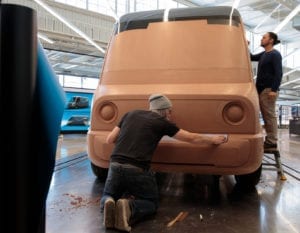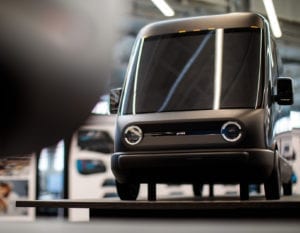Amazon has begun designing its next-generation electric delivery van, which will hit the roads in 2021.
As previously reported by CiTTi, the company has ordered 100,000 electric delivery vans – the largest-ever order of electric delivery vehicles – from US EV startup Rivian as part of Amazon’s commitment to meet the Paris Agreement 10 years early.
Amazon’s Climate Pledge also calls on signatories to become net zero carbon across their businesses by 2040, a decade ahead of the Paris Accord’s goal of 2050.
“We’re trying to build the most sustainable transportation fleet in the world,” said Ross Rachey, director of Amazon’s global fleet and products. “It also needs to be the most functional, the highest performing, the safest.”
Amazon’s transportation team spent 18 months evaluating a variety of EV options to reduce its carbon footprint.
The chosen vehicles – manufactured at Rivian’s plant in Normal, Illinois, USA – will come in three size variants and support multiple battery sizes so they can be optimised for specific delivery routes.
“We are focused on driving efficiency into every aspect of the vehicle design – everything from cabin heating to driver ergonomics to drivetrain design has been optimised for time and energy,” said R.J. Scaringe, CEO of Rivian.

“And then the echo effect of this, of causing other logistics players in this space to also look at how they drive up efficiency within their fleet, will have a very large impact.”
Drivers who currently deliver Amazon packages informed the vehicle’s design and functionality, from how the seat feels to the ease of getting in and out of the vehicles, package loading and unloading, and visibility.
Each vehicle is designed to include a suite of advanced safety technology and industry-leading features, including automated emergency braking, front wheel and all-wheel drive options, lane keep assist, a pedestrian warning system, traffic design recognition, and an automatic warning system that detects and alerts distracted driver behaviour.

The design incorporates a raft of Amazon technology for drivers, including a digital instrument cluster and central display screen integrated with Amazon’s logistics management, along with routing and package delivery technology systems to make it easier for drivers to focus on operating the vehicle.
The system removes the need for extra devices that provide address and mapping information.
Furthermore, Amazon Alexa will be integrated into the vehicle so drivers can ask for help or use simple voice commands in the cargo bay when sorting packages without having to manually enter commands or consult handheld devices.
The company plans to have 10,000 of the vehicles on the road as early as 2022 and all 100,000 vehicles on the road by 2030.




